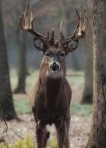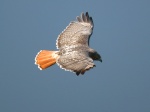All good things must end, they say, and whether this year-long blog has been worthwhile or not, its end has come. But if our lives are in synch with natural cycles, endings are also opportunities to begin.
Shortly after my book Waiting for Coyote’s Call: An Eco-memoir from the Missouri River Bluff was published last year, my editor at South Dakota State Historical Society Press, Martyn Beeny, suggested that I write a weekly blog of happenings on the Missouri River bluff—a kind of addendum to Coyote’s Call. I agreed to give it a try, and soon I was looking forward to sharing with readers each Monday some happening of the week on our bluff. Now the year has flown, and never a week has passed when “nothing happened.” There is a new wildflower in bloom, a blizzard to endure, a skunk spraying our backdoor with perfume or the sighting of a bird I’d never seen.
It’s been a great year, and I have accumulated 50 short essays of life in our prairies and woods and the thoughts this life has provoked. Truth is, I’ve been carrying a pocket notebook for 28 years, recording daily appointments, occurrences, thoughts and encounters with serendipity. Coyote’s Call itself grew in large measure from these notebooks, observations and ideas that otherwise might have vanished into the ether I breathe. So in fact this process is not new to me, except the technology, a new way of reaching out to friends old and new, readers and others who might take interest in the musings of an amateur naturalist whose eyes and heart are open to the workings of the ecosystem of which we are part.
I have appreciated the comments and reactions of readers who took time to respond, either directly to the blog, or indirectly in other ways. I have made new acquaintances with people who share my love of the natural world and who somehow related to my quirky way of seeing things. Thus, perhaps the end of my weekly posts is less a closing door than a door left ajar, a portal through which I peer further down the road, an opportunity to take these musings to a new audience through more traditional means. In short, I hope to shape these and other essays and observations, along with photographs, into a new book, something I might call “A Year on the Bluff.”
With winter solstice approaching, I close this phase of the journey with the final paragraph from Waiting for Coyote’s Call. I hope that my readers have enjoyed both blog and book, and I hope to see you all somewhere down the road.
Midnight, December 21st, the longest night of the year. In the kingdoms of birds, mammals and plants, this is a time of sleep. In the morning, in the new year, in the spring, we tell ourselves, all will be revived. The annual cycle of rebirth will come. But in the post-modern world, not all women and men take note. Will we humans, like the rest of creation, open our eyes tomorrow to a new world, a world in which renewal is both possible and required? We wait by the solstice fire for the coyote’s call.
Happy Trails,
Jerry Wilson




